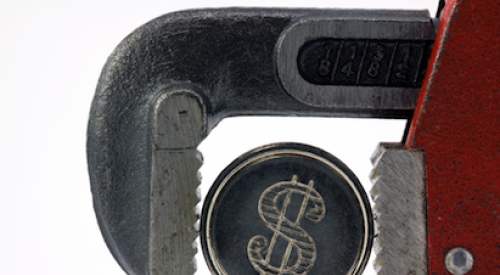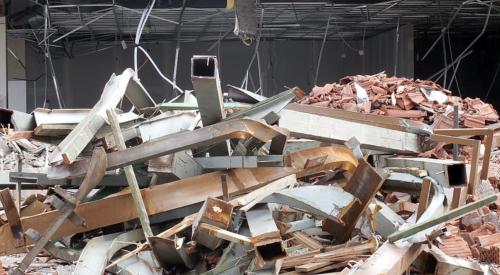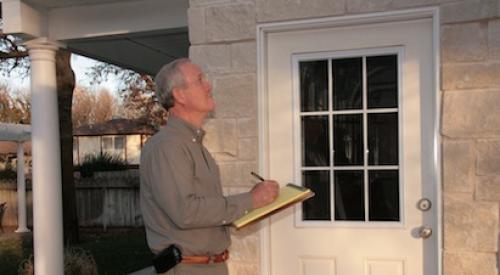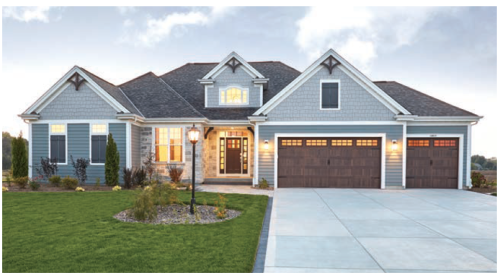| As part of WasteCap Wisconsin’s recycling program in the Parade of Homes, 30-yard containers for wood scraps were placed at the sites.
|
Every year America’s residential and commercial builders combined take on 136 million tons of waste, according to the EPA. Jenna Kunde would like to see them all go on a diet -- and gain some cash "muscle" while doing so.
Kunde, who is executive director of the non-profit WasteCap Wisconsin, wants to help builders save money on their waste handling costs by recycling. To do this, she heads up a team of experts that consults with clients on what she calls a business-to-business peer exchange. Here’s how it works. A home builder calls WasteCap asking how he can cut back on the amount of waste his job sites generate. WasteCap qualifies him by asking him questions about his business operations and goals.
Based on this information, WasteCap then brings in a team that might consist of an architect (experienced with putting spec language on waste reduction and recycling in construction documents) and a fellow builder (with real-world experience in waste reduction and recycling). The team walks through the business operations with the client-builder and his project staff, asking questions such as, "You’ve told us these are the materials that you’re going to be generating as waste. What kinds of quantities do you think you’re going to come up with? Which of these quantities do you think you can recycle? What markets exist for these recycled materials?" Then they come back with recommendations for a program.
They outline the builder’s options, and give him a worksheet that helps him identify elements such as amounts of trash, hauler costs, labor costs to recycle and so on.
A Success Story
As part of their annual Parade of Homes, the Metropolitan Builders Association of Greater Milwaukee recently asked WasteCap to develop a recycling program for 10 of the builders who were taking part in a special Green Built Home Program developed by the Wisconsin Environmental Initiative, a non-profit environmental group.
"Wisconsin state law mandates recycling of cans, plastics, newspapers," explains HBA executive director Matt Moroney. "Part of the Green Built checklist included a recycling component that builders had to incorporate into their building process in order to meet Green Built certification. We wanted to highlight that [recycling of construction waste] can be done in a cost-effective manner to see how well it would be received by the builders and, more importantly, by the general public."
To do this WasteCap worked with the builders, targeting materials to be recycled. They found that wood debris generated during framing and cardboard debris from the finish stage constitute about half a site’s waste.
WasteCap sent out RFPs to waste haulers in the area asking for bids on the project. Six replies came back and two haulers were chosen.
The local HBA and four local sponsors paid for all the containers that would be used at the job sites. Each site had a 30-yard container for framing scraps and an enclosed eight yarder for cardboard.
"We tried to use the K.I.S.S. formula," says Kunde. "It was important to make it as easy as possible for the subs to use the containers. Putting them down the street would not have worked. We realized that in construction, time is money."
WasteCap’s -- and the home builders’ -- success with the program was pretty impressive. The scrap framing lumber picked up by the haulers and turned into mulch was returned to the builders for use as a landscaping material. More importantly, the builders found they had recycled 46 percent of their total waste and saved 57 percent of their normal container costs. Builders who took part in the program displayed a special certificate on their models and were recognized by an award that highlighted the recycling process and recognized the builders that took part.
Craig Rakowski, whose company, James Craig Builders, Inc., was one of the ten participants, is cautiously bullish on the results. He says that the Green Built Program was the first time his firm had any experience with WasteCap and their recycling program. He calls it a good "learning experience."
"It was less coordination than I thought," he notes, "but we’re still working on what the [future] costs of dumpsters and recycling will be. The home building business is customer-driven and now it’s just a matter of sitting down and figuring out how much it’s going to cost us and, like everything else, whether that [additional] cost is going to be born by the consumer."
Rakowski was impressed, however, with the subcontractors’ enthusiasm for recycling. He says most of the resistance to job-site recycling comes from the subs who must make the program work. "I was surprised that they took to it as much as they did," he says. "This was always one of our concerns."
To boost the idea with their membership, the HBA also sponsored a "Talk and Tour" so that other builders could see the recycling program’s success. Not only was it well received, but Moroney is now looking at the next step. "We’re probably going to incorporate this [recycling] into our next Parade," he says. "But the important question is how do we get it to catch on outside of the Parade? I think we’ve got some builders who were part of the Parade that are interested in incorporating recycling efforts in their building plans. However, how do we reach the broader audience of all the builders who are members of our association?"
Both Kunde and Moroney are upbeat about the future of recycling construction waste. As they point out, there are recycling companies out there looking for waste and are likely to provide containers to builders at minimal or no cost. They do admit that the first efforts may take some extra time for the learning curve. But the end result, they note, is a win-win situation.
For more information on WasteCap Wisconsin, call (414) 961-1100 or go to www.wastecapwi.org
Paul Sedan lives in Charlotte, N.C., where he began his own home building and remodeling business after working for a production builder. He has since hung up his tool belt and strapped on the word processor. He is the author of The Factory-Crafted House (Globe-Pequot Press, 1992) and is a keen observer of the green building scene.












